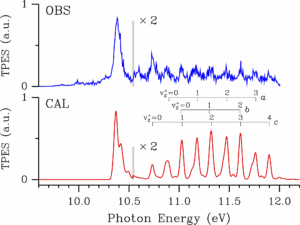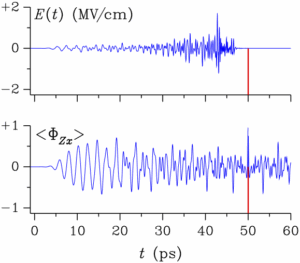Non-rigid molecules, that is, exhibiting one or more large-amplitude motion such as internal rotation, inversion, migration, or pseudo-rotation, make up for a substantial part of observable molecular systems. These molecules have been, and still are, the subject of theoretical developments. One reason for this is that the harmonic approximation cannot be used in their case and there is no general theoretical approach to treat them. In parallel, due to recent improvements in laser performance, the modeling of molecular systems subjected to laser or terahertz pulses is also an active field of research. It gives rise to numerous applications and new theoretical results.
The SYSTEMAE team is involved in the development of theoretical approaches designed for non-rigid molecules and in the modeling of the effect of femtosecond laser pulses. Some of the studies undertaken are listed below:
-
analysis and modeling of the high-resolution spectrum of non-rigid molecules of astrophysical interest for their detection in interstellar media,
-
control of molecular systems using laser or terahertz pulses,
-
analysis and modeling of the photo-ionization spectrum of non-rigid molecular systems exhibiting a strong Renner-Teller effect.
Photoionization spectroscopy of non-rigid molecules
The goal of photoionization spectroscopy is to study the electron emitted by a molecule when it ionizes due to a VUV photon. It is theoretically challenging as it requires accurately modeling the energy levels of the neutral molecule and those of its cation. This is well illustrated by the modeling, carried out by the SYSTEMAE team, of the photoionization spectrum of methylene (CH2), a highly non-rigid radical.

Figure 1 – Variations as a function of the bending angle γ= ∠ HCH of the potential energy V(γ) of methylene in eV for the ground electronic state X3B1 of the neutral (CH2) and for the X+2A1 and A+2B1 sub-states of the cation.
As shown by Figure1, methylene is characterized by a very low barrier to linearity that precludes harmonic treatment of its valence mode. This must be treated as a large-amplitude motion and the singularity that occurs when the molecule approaches its linear configuration (γ= π), characterized by an infinite rotational constant, must be taken into account. As Figure 1 also demonstrates, the CH2+ cation is difficult to treat theoretically due to a very pronounced Renner-Teller effect, resulting in two electronic sub-states that rapidly diverge as one moves away from the linear configuration. These theoretical difficulties have been overcome and Figure 2 shows a fairly satisfactory comparison between the observed and calculated photoionization spectra.

Figure 2 – Observed photoionization spectrum (top panel) and calculated photoionization spectrum (bottom panel) of the X+ 2Πu ←X3B1 ionizing transition of the CH2 radical. For both spectra, the y-axis corresponds to the quantity of electrons emitted by the molecule when the energy of the electromagnetic radiation is varied, x-axis. The y-axis scale is multiplied by 2 for energies above 10.54 eV. In the bottom panel, the Frank-Condon progression denoted a originates from the (000), K′′= 0 level of the neutral state and connects the (0v2+0), K+ = 1 level of the A+ 2B1 electronic sub-state of the cation. The
progressions noted b and c originate from the (000), K′′ = 1 level of the neutral connect respectively the (0v2+0), K+ = 2 et K+ = 0 levels of the A+ 2B1 electronic sub-state of the cation.
Spectroscopy of non-rigid molecules of astrophysical interest
High-resolution spectroscopy is one of the main tools of astrophysics. It allows us to determine the chemical composition of interstellar media and to measure many physical parameters such as velocity, the value of the magnetic field, etc. Astrophysicists are particularly interested in partially deuterated molecules because they provide important information about chemical processes at the surface of ice grains. In this context, the SYSTEMAE team has been working on high-resolution spectroscopy of partially deuterated methanol varieties, CH2DOH and CD2HOH, to model their spectra in the millimeter to terahertz range.
Like normal methanol (CH3OH), CH2DOH and CD2HOH molecules are non-rigid molecules and exhibiting an internal rotation of their methyl group relative to their hydroxyl group (OH). Unlike normal methanol, this internal rotation is accompanied by a significant variation in the generalized inertia tensor with the torsion angle, complicating the modeling of their energy levels. A 4-D model has been developed that solves the Schrödinger equation for torsion using Gaussian quadrature. The application of this model to CH3OH, CH2DOH, CD2HOH, and CD3OH molecules is shown in Figure 3 and highlights the qualitative differences in their torsional energy levels.

Figure 3 – Variations of the torsional energy as a function of the rotational quantum number k for CH3OH, CH2DOH, CD2HOH, and CD3OH. Only the three first torsional states are shown. For the two symmetrical species CH3OH and CD3OH, level crossing is allowed because torsional levels belong to different symmetry species. For the two partially deuterated species CH2DOH and CD2HOH, their lower symmetry leads to avoided crossings.
Figure 4 shows the result of a high-resolution spectral modeling of CH2DOH. The observed and calculated spectra in the far-infrared region extending from 40 to 41 cm−1 are compared. There is a good agreement between theory and experiment, both for the position and intensity of the transitions. The calculation does not go beyond vt = 2, which explains why some transitions in the experimental spectrum are not present in the theoretical one.

Figure 4 – A comparison between observed and calculated absorption spectra for the CH2DOH species. The absorption coefficient is plotted as a function of the wavenumber σ in cm−1. Some transition of the observed spectrum are missing in the calculated one because the present modeling does not go beyond vt = 2.
Molecules subjected to laser or terahertz pulses
With the advent of very powerful lasers delivering pulses whose shape can be varied, molecular alignment is experiencing a resurgence of interest. Such pulses can be used to counteract the random angular distribution of molecules in the gas phase, and there are numerous applications in both physics and chemistry.
The SYSTEMAE team’s contribution to modeling the effects of laser or terahertz pulses is based on quantum optimal control theory. The shape of the terahertz pulse resulting in maximum orientation of an H2S molecule at time T was determined theoretically. At the time, this type of result was only available for linear molecules. Figure 5 shows the variations obtained for the electric field of the terahertz pulse and the orientation of the molecule. For t = 50 ps, a nearly maximum orientation with ⟨ΦZx⟩= 0.960 is achieved.

Figure 5 – The variations as function of the time t in picoseconds of the electric field of a terahertz pulse linearly polarized along the Z axis are shown in the upper pannel. The corresponding variations of the orientation ΦZx of an SH2 molecule are shown in the lower pannel. The shape of the terahertz pulse was obtained using quantum optimal control theory and leads to a nearly maximum orientation of the molecule at t= 50 ps.
Contacts :
Laurent Coudert